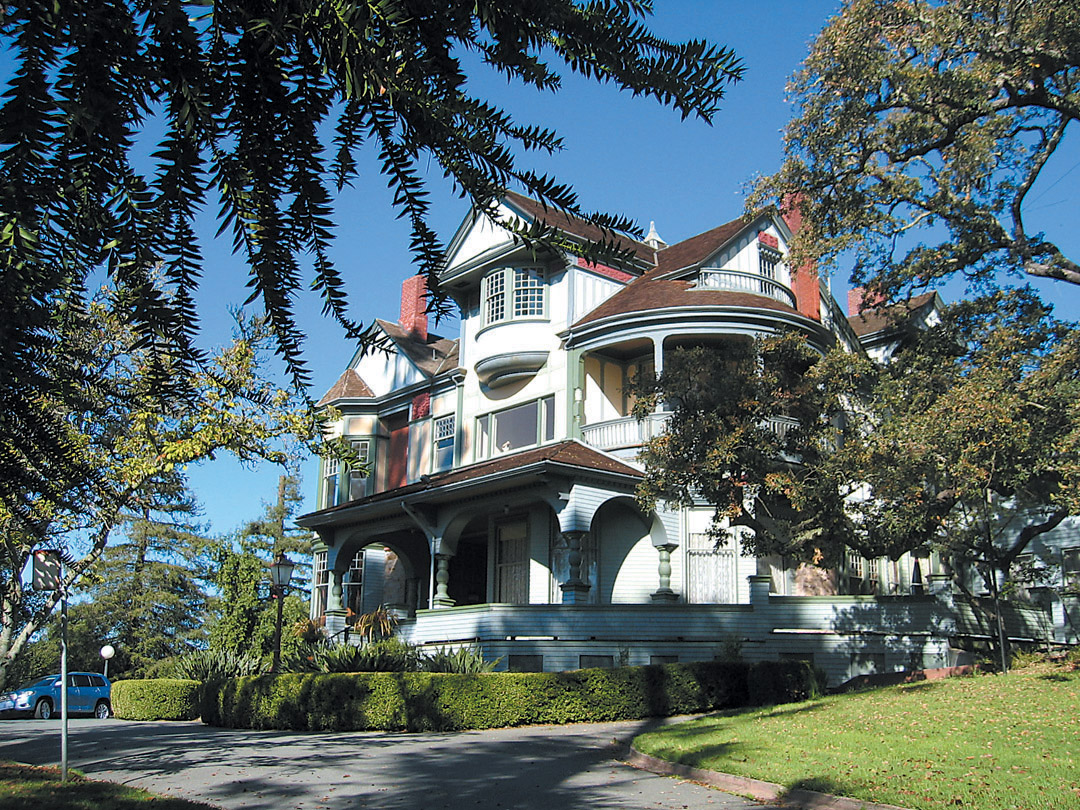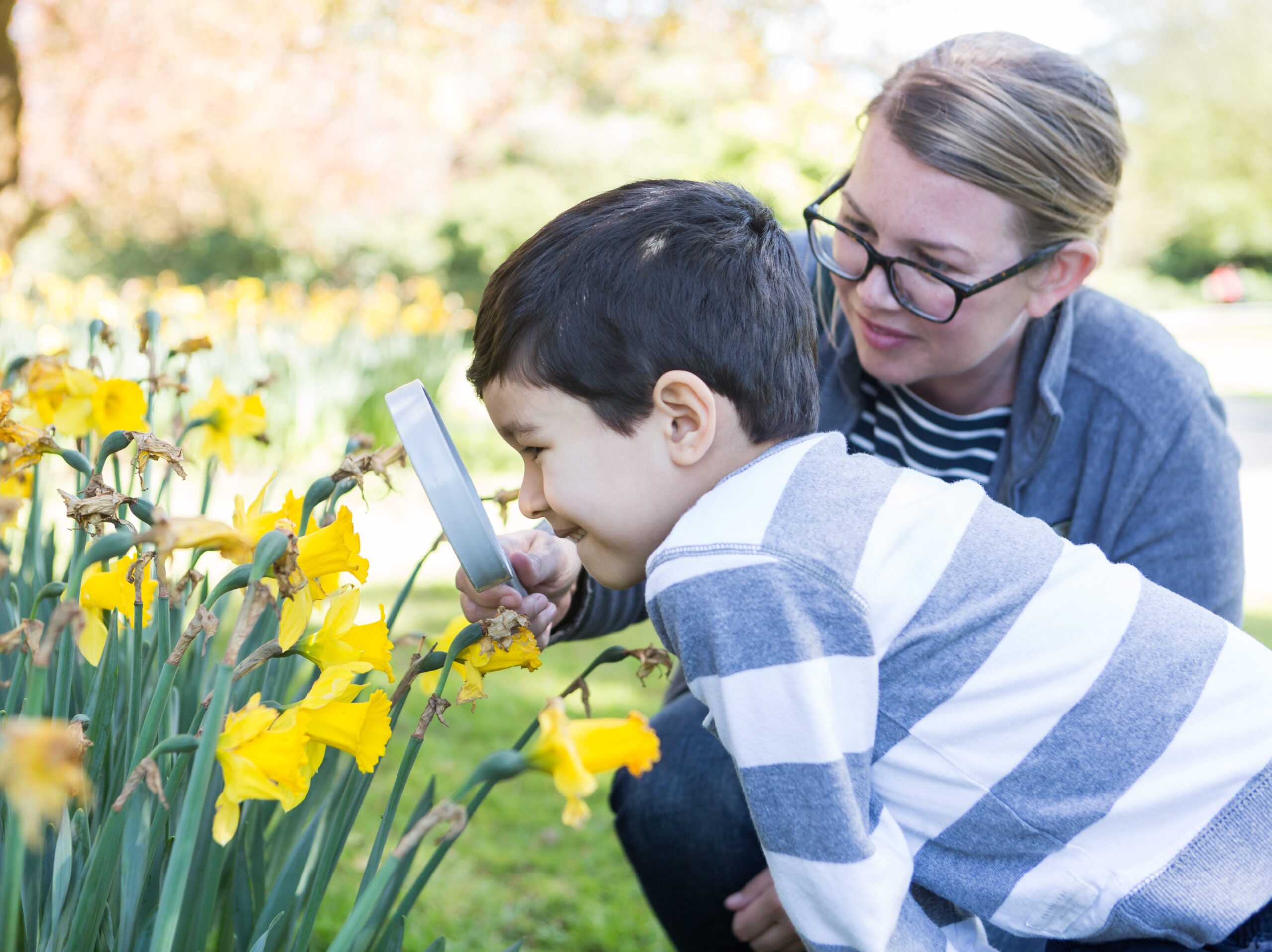

Contributor
- Topics: Archive

If you had attended a garden party at Falkirk in the 1920s, you would have strolled past exotic agaves and New Zealand flax, been shaded by huge Douglas-firs, Sierran redwoods, and bunya bunya trees, viewed the rock garden planted with azaleas and hydrangeas, and enjoyed masses of brightly colored annuals along the boxwood-lined drive. Your hosts would have been Mr and Mrs Robert Dollar; he was a lumber magnate who founded a shipping line and became one of the hundred richest men in the world, featured on the cover of Time magazine in 1928.
Eighty years later, a new group of guests are strolling under the same bunya bunya trees (Araucaria bidwillii), taking in views of shapely succulents, colorful grasses, and quirky blossoms in a series of new gardens created on the grounds by the Marin Master Gardeners to demonstrate how to plant glorious gardens with appropriate, water-saving plants.
Falkirk is an eleven-acre estate anchored by a handsome three-story home, a blend of Queen Anne and Eastlake styles, built in 1888. By that time, San Rafael had matured into an elegant summer-home community, from its beginnings in 1817 as a mission outpost and then a transportation and commercial hub once the railroad was built in 1869.
Dollar bought the house in 1906. He was born poor in Falkirk, Scotland, emigrated to North America, and founded lumber businesses and the Dollar Steamship Company, which opened the trans-Pacific trade to China and inaugurated the first round-the-world passenger and freight service. Margaret married Robert in 1874; she was an adventurer in her own right and voyaged abroad with her husband for months at a time.
The family enlarged the house and made changes to the grounds. In 1927, a new greenhouse and lathhouse replaced the old barn where Mrs Dollar had kept her electric car. The Victorian garden in front of the house was replaced with a sweep of lawn and a brick-bordered pond. The Dollar family and descendents continued to live at Falkirk until the 1970s, when a developer proposed tearing down the mansion and constructing condominiums on the property.
The threat of losing another piece of local history spurred Marin Heritage to action. The citizens group gathered signatures for a ballot initiative proposing that the city purchase the property. The measure passed resoundingly in November 1974, and the Dollar mansion soon became Falkirk Cultural Center, featuring an art gallery and a lively rental business as an event and wedding venue.

Renovations and Restorations
While the mansion underwent extensive restoration in 1977, the landscape, described as a “park-like setting traditional for grand country estates of the period,” was showing its age. Trees had died, exposing tender plants to withering sunlight; other trees had grown up to shade out sun-loving exotics. Black acacias had seeded everywhere and Scotch broom encroached. In 1995, a Conceptual Grounds Master Plan was completed, but there were never funds to implement it.

The 1927 greenhouse was restored in 1985, but by 2000, it was in disrepair again, with most of the glazing gone and luxuriant stands of weeds inside. Under the leadership of Falkirk director Jane Lange, funds were raised through individual donations and grants to renovate the greenhouse in 2002. The Marin Master Gardeners became involved with the project at that time, planting the borders around the greenhouse and a cottage garden behind it.
Alfred Stone, a retired architect and Master Gardener, designed the Victorian-style lattice fence and entry arbors that enclose the garden against the deer. An amphitheater was built on the sloping ground, using dressed sandstone from a nearby church, which the Dollars had supported, when its gothic structure was replaced with a modern one. A steel and concrete sculpture, titled “Collision: Lava Ship/Trellis Ship” by environmental artist John Roloff, had become part of the garden in 1984.
The next parties in the gardens at Falkirk were work parties, as weeds were smothered under cardboard and tree chippings, plants were planted, and irrigation installed. The greenhouse found use as a nursery for tomato plants grown by the Marin Master Gardeners for their annual tomato plant sale.
The latest wave of improvements at Falkirk began in 2007, when Master Gardener board member Glenn Smith visited the greenhouse and wondered if the site could be better used to dovetail with current concerns and programs on water use and appropriate plantings. The Master Gardener board approved a partnership with Falkirk Cultural Center. By December 2007, a memo of understanding was unanimously endorsed and approved by the San Rafael City Council.
The new plan focused on two areas: the historic rock garden adjacent to the house, and a sloping site between two driveways. These areas would be developed into a succulent garden and a garden of plants from the world’s mediterranean-climate regions.

A New Succulent Garden
Heading up the succulent garden planning were Leslie Hutchinson and Jessica Wasserman, who maintains the succulent garden at Marin Art and Garden Center, in Ross. A plan was drawn by landscape architect Fred Warnecke, who has served for years on San Rafael’s Park and Recreation Commission and is a long-time Falkirk advocate. The core of the original Victorian rock garden was preserved as an important historical feature, set off with new paths of decomposed granite, sitting areas, and planting beds for succulents and native plants.
To prepare the site, declining crabapple trees, privets, and pittosporum were removed. Three chitalpa trees (XChitalpa tashkentensis) were planted in November 2008, to provide shade on this hot, sunny site.
Throughout that fall and winter, plants were secured for the garden. Ernesto Sandoval, curator of the UC Davis Botanical Conservatory, walked the group through the greenhouses and contributed specimens suited to San Rafael’s climate, including a rare Aloe excelsa. Closer to home, landscape architect David Schwartz offered plants and cuttings from the Marin Bolinas Botanical Garden, the treasure trove of succulents collected by his late father, Dr Herman A Schwartz. Additional plants were propagated from the private collections of fellow Master Gardeners.

Plants from Mediterranean Climates
While the succulent garden was being planned, Master Gardener Gail Mason was asked to chair a group to develop the second garden, on an empty slice of sloping land opposite the greenhouse.
“I love Australian plants,” says Mason, “and thought of putting in a mini-arboretum of plants from all the mediterranean-climate regions, with educational signage so visitors could learn about what else can grow here besides lavender and rosemary.” Mason spent hours photographing and researching plants at the San Francisco Botanical Garden and the UC Santa Cruz Arboretum, to refine a list of mediterranean-climate plants that are both deer-proof and drought tolerant.
Fred Warnecke refined Mason’s conceptual sketch into a plan with paths and beds where plants would be grouped by country of origin. Now, the space is alive with deep red New Zealand flax (Phormium) amidst a swath of golden pheasant’s tail grass (Anemanthele lessoniana) enclosing beautiful, rarely-seen species of Acacia, such as A. vestita, A. boormanii, and the weeping A. cognata. Mason’s big wish was to dispel the myth that all acacias make you sneeze and are invasive.
The garden skews towards the floras of Australia, South Africa, Chile, and California/Baja. As Mason explained, there are plenty of places to see plants from the Mediterranean Basin, “but not so many places to see Banksia ’Raspberry Frost’, silver tree (Leucadendron argenteum), or the wonderfully quirky Lobelia tupa.” Native plant specialist and Master Gardener Leita Brown designed the California plantings.

Meanwhile, Master Gardener Sandra Meyers planted a cottage garden of pollinator plants behind the restored greenhouse. The unplanted area adjoining the coast live oaks (Quercus agrifolia) was given a sharper focus as an Under Oaks Garden. It is now planted with brilliant monkey flowers (Mimulus hybrids), dry-shade groundcovers such as Geranium macrorrhizum ‘Bevan’s Variety’ and Rubus pentalobus, and brightened in spring with narcissus. Further up the hill grow swaths of alumroot (Heuchera maxima) and, in the sun, a huge sweep of summer-blooming tarweed (Madia elegans).
Plants are labeled in large, clear type, and educational signs provide horticultural information for garden visitors.
Financing has been cobbled together: grants from the Marin Master Gardeners, and from Falkirk Cultural Center; rebates from Marin Municipal Water District; donations from The Urban Farmer in Mill Valley, Hunter Industries, and Mekisich Horticultural Services for irrigation; and donations of building materials and soil from Shamrock, American Soil, and the Marin Resource Recovery Center. Plant donations and discounts from Sunnyside, Green Jeans, Mostly Natives, and Flora Grubb Gardens nurseries filled the beds. The men at Center Point, a treatment center in San Rafael, donated their labor. Master Gardeners, their families, and neighbors put in thousands of hours of work.
Now that this phase is completed, the gardeners are making adjustments as plants fill in. New challenges await: making better use of the greenhouse to propagate and sell plants from the gardens; perhaps creating a Menzies garden in honor of Robert H Menzies, a businessman whose avocation was botany and the study of California natives, and whose family lived next door to Falkirk for many years (Robert’s nephew, Arthur L Menzies, was supervisor of plant accessions at San Francisco’s Strybing Arboretum and Botanical Gardens in the 1960s). Look for more parties in the garden at Falkirk—both the working and celebrating kind—as the gardens continue to expand.
If You Should Like to Visit . . .
The gardens at Falkirk Cultural Center are open daily during daylight hours, free of charge. The Center is located at 1408 Mission Avenue, in downtown San Rafael, California. For information about activities at the center, visit www.falkirk culturalcenter.org or call 415/485-3328.
For information about the Marin Master Gardeners, their training programs, and volunteer opportunities, visit https://groups.ucanr.org/MarinMG/.
Share:
Social Media
Garden Futurist Podcast
Most Popular
Videos
Topics
Related Posts

Ground Up Science for Greener Cities with Garden Futurist Dr. Alessandro Ossola
Spring 2023 Listen to the Podcast here. Alessandro Ossola is a scientist who gets very excited about the challenge of climate change allowing for an

Readying Urban Forests for Climate Realities with Garden Futurist Dr. Greg McPherson
Winter 2023 Listen to the Podcast here. “Going from the mow and blow to a more horticulturally knowledgeable approach to maintaining the landscape. And that

January Showers Bring February flowers…
Fall 2022 It may not quite have the same ring to it as the old English proverb, but it has a lot more truth to

Low Maintenance Gardens – Better for Pollinators and People
Autumn 2022 “I come out every day. It’s therapy, my meditation.” Janet’s young garden transformed from overgrown, invasive plants to mostly natives. The dailiness of








Responses